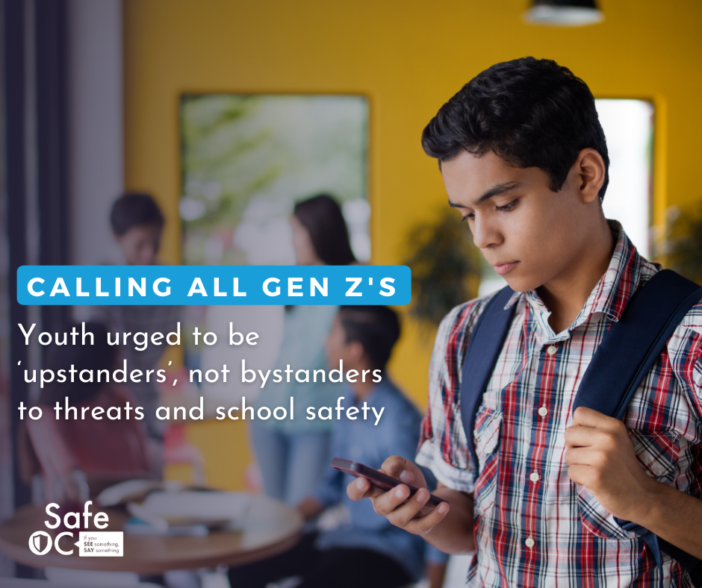Generation Z, those born between 1997 and 2012, are often described as “digital natives,” the first generation that has grown up ensconced in a world dominated by online and social media presence.
While older generations aren’t insulated from online dependency, Gen Z seems to have a much deeper attachment to social media. A 2018 Pew Research study found 95 percent of 13- to 17-year-olds had access to smartphones and 45 percent were “almost constantly” online.
And that was before the pandemic further fused Americans and their devices.
Whatever the social and political implications of that, there is little doubt that members of Generation Z, with their online savvy and presence, are ideally positioned to become the first line of safety from digitally promulgated danger and violence.
The flip side, of course, is that they are often the most likely to stimulate discord and be steered into the dark web or be victimized by predators.
To combat these dangers, SafeOC is spearheading the local application of the See Something, Say Something campaign by the U.S. Department of Homeland Security to raise public awareness about safety and prevention of violence and terrorism. Through their efforts, they are hoping to encourage younger residents to report any suspicious activity they may witness online via social media platforms.
Because Gen Z has a greater likelihood of witnessing suspicious activity online due to their increased activity, particularly on social media, officials are imploring them to be an early warning system.
“Make sure if you see something that concerns you or makes you feel not safe, report it to a trusted adult,” is the message stressed by Sgt. Rachel Puckett of the Orange County Sheriff’s Department’s SMART (School Mobile Assessment Resource Team) unit. That person can be a parent, teacher, administrator, law enforcement or a School Resource Officer.
“It almost takes a village,” she says about administrators, teachers, law enforcement, and students working together.
Throughout the county, law enforcement, teachers, and administrators learn about the evidence and science of Threat Assessment Training to help them to better recognize potential trouble spots.
Because Gen Z covers a wide age range, from 10 to 25 years old, their experiences and relationships with the web and online communities vary greatly.
Those still in K-12 comprise a very important segment when it comes to school safety. And because they are involved in countless online communities and talking amongst themselves all the time on a variety of social media platforms, they have specific knowledge that others may not.
The importance of the See Something, Say Something concept is that school violence and local attacks don’t happen in a vacuum and usually are preceded by clues.
In the final report and recommendations for the Safe School Initiative one of the key findings was that, “Prior to most incidents, other people knew about the attacker’s idea and/or plan to attack.”
The report was issued in 2004 in response to the attack at Columbine High in Colorado by two teens who killed 13 and left 20 injured. Since then, similar teen-initiated attacks occurred in Parkland, Florida and Santa Fe High in Texas in 2018. Plus, the rampage at Sandy Hook Elementary in 2012 have symbolized the devastation that can occur in schools.
Those events permanently altered perceptions. And while many steps have been undertaken to improve safety, the psychology and fear are the same.
“In the wake of these attacks, fear of future targeted school violence has become a driving force behind the efforts of school officials, law enforcement professionals, and parents to identify steps that can be taken to prevent incidents of violence in their schools,” the Safe School Initiative report read.
It remains to be seen how the pandemic, not to mention the surge in gun availability and purchase by adults, have affected student interaction and the likelihood of escalated violence on campus and in our communities.
An ever-present danger
Orange County is not immune from potential violence on campus.
In April, a 14-year-old was detained after allegedly making online threats via social media against an Irvine middle school. And a month earlier a minor was detained and taken into custody for online threats aimed at some Newport-Mesa Unified School District high schools.
According to Campus Safety Magazine, citing a database of K-12 shootings, since 1970 there have been 1,924 instances of gun violence on campuses in the U.S. resulting in 637 deaths. The database defines school shootings to include whenever a gun is brandished or a bullet strikes a school building.
Although there have been rare shootings in, and around, schools stemming from personal or gang disputes, so far Orange County has been spared mass casualty events on school grounds. Schools regularly engage in active shooter drills, but prevention and intervention are the best lines of defense.
In a YouTube video by the Brea Police Department, School Resource Officer Shannon Buckels talks about the importance of helping police explore potential threats.
“When they’re investigated, sometimes it’s discovered that the person who made the post actually had access to firearms or other weapons, sometimes it’s fake,” she said. “But we don’t know until it’s reported and investigated… These threats are no joke, and they are fully investigated by the Brea Police.”
Once on the case, OC detectives are adept at discovering the truth.
“My detectives all have experience as SROs,” said Puckett of the Sheriff’s Department. “It takes a special kind of officer to work with kids, gain trust, and build rapport.”
Although Puckett said nine of 10 investigations don’t lead to further action from the police, they are never taken lightly. In the post-COVID era, Puckett says there has been an uptick in tensions in schools.
“Children are learning to become social again,” she said. “They’ve had a lack of socialization, their communication has been stunted, and many don’t want to be in school. There are going to be things said and threats.”
A perception Puckett tries to dispel is that when you say something, you are ratting someone out or getting them into trouble.
“We don’t just take kids to jail,” she said.
If a child needs services and mental health treatment, Puckett wants to make sure they get it.
“We want them to get through school and thrive in life,” she said.
Non-credible threats and hoaxes
Many kids are prone to make claims they have no intention or ability to carry out. And then there are those who take advantage of the heightened fears and attention to make outlandish claims, spread rumors, and create hoaxes.
For example, in December last year, a trend on TikTok — a social media app that often features short videos with pranks — declared a “National School Threat Day.” The hoax ignited thousands of videos warning of school shootings across the country and putting countless schools on heightened alert.
Public safety and law enforcement officials urge that when students see something worrying not to respond, repost, share, or like the post. That only fuels the messages. Rather than being bystanders, it is urged that students be “upstanders.”
The philosophy has gained traction in recent years on the idea that when you stand up, those who mean harm are more likely to stand down.
Not just a K-12 issue
For the older Gen Z members in college, the issue of campus violence and gun use does not end. If anything, it is more complex. The problem was forcefully driven home after the 2007 Virginia Tech massacre left 32 dead. But the problem is not contained to one instance.
According to Campus Safety Magazine, the instances of college shootings are rising with 190 people intentionally shot, not including the shooter, at 142 schools between 2001 and 2016.
In February 2022, the UCLA campus was on high alert and classes canceled after a former lecturer threatened to kill a professor.
Although psychographic studies of Gen Zers show social consciousness bends toward an end to gun violence, they also report the “least positive life outlook, including lower levels of emotional and social well-being than older generations,” according to a McKinsey and Company report.
These include greater suicide ideation, mental distress, anxiety, and a lower likelihood to seek out mental healthcare.
Coupled with the alcohol use that accompanies college attendance, a soaring homicide rate nationally from which students are not immune, successful lobby efforts to allow guns on campus, the grounds for gun violence on college campuses is fertile.
In reviewing the 190 shootings, the New York Crime Commission concluded, “Based on current trends, the problem is likely to become much graver over the next decade.”
Whether in grade school or college, reporting remains vital. There are numerous ways and venues through which one can See Something, Say Something. Locally, the Orange County Intelligence Assessment Center stands ready to respond to reports and concerns.
If you or someone you know witnessed suspicious activity online please report a tip through the SafeOC.com website or directly to the Orange County Intelligence Assessment Center here.
 Behind the Badge
Behind the Badge




